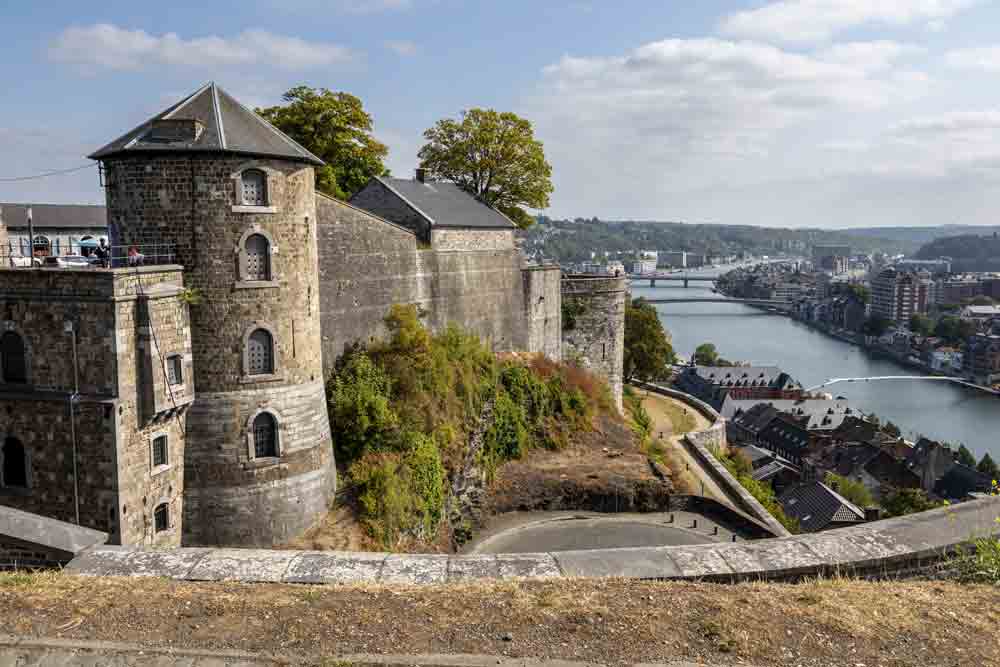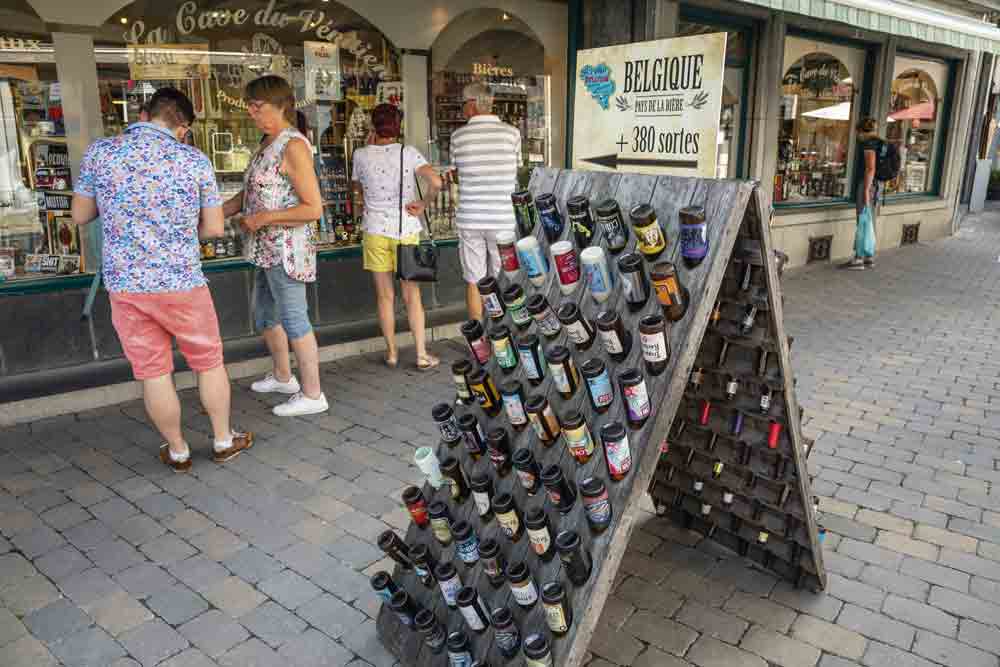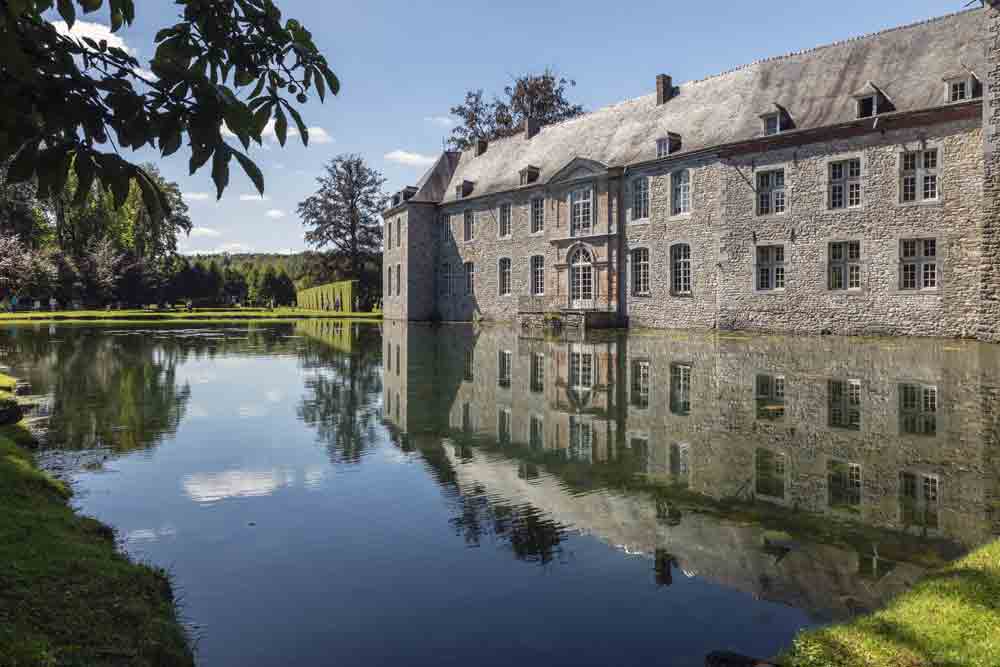Motorhome travel: Belgium and the wonders of Wallonia
Words: Helen Werin Photos: Robin Weaver
Namur’s symbol is the snail to exemplify the slow, relaxing pace of the capital of Wallonia (French-speaking Belgium). So how come we’re being whipped around corners, down narrow streets of magnificent buildings and alongside the rivers Sambre and Meuse in the shadow of the famous citadel by ‘mad’ Max (and I mean ‘mad’ as in speedy) in a rickshaw-like contraption attached to a bike?
I’m scrawling all over my notebook with great difficulty, trying to take down some of the fascinating snippets of Namur’s chequered past that local lad, Max, is churning out, whilst clinging on to my seat and hoping that we don’t go over any more bumps or mow down any pedestrians.
But it’s late Sunday afternoon and there appears to be hardly anyone about in this compact, laid-back city as we scoot around in our pousse-pousse (literally, push-push, though the bike is electric). Just as well, I think, as we whizz past the red brick parliament building, the Palace of the Bishop (1760) and the ‘old’ Bishop’s Palace, now used for functions by the Wallonian prime minister and the government.
Art Nouveau buildings and beautiful balconied houses flash by. In the Place Saint-Aubain, opposite the cathedral with its intricately carved vaulted ceilings, is the elegant Brasserie François where, earlier, we enjoyed a fabulous lunch finished off with a Dame Blanche (vanilla ice cream, loads of cream and hot chocolate) in a very romantic curtained booth. Yes, Namur is well-known for its delectable cuisine, too.
As we pass a statue of stilt runners I vow to find out more about it later. It’s yet another puzzling piece of Wallonia’s past to add to all the other zany and offbeat facts that I’ve been picking up about this region.
It was actually the eccentric, outlandish and, sometimes, outright barmy that had drawn me to Wallonia again. We’ve visited many times before, but were usually too intent on getting our fun rail-biking ‘fix’ in the Molignée Valley or laughing at the cheeky sculptures in Durbuy’s Parc des Topiaires (topiary gardens) to explore the villages of Silly, Wierde, Bra, Ham and Dance or, indeed, to spend time in Namur itself.
This trip has changed that. For a start, we’re briefly sans Sophie, our teenage daughter, who’s taken off on her own with a backpack after seven weeks cooped up with us in Roly, our motorhome.
Apart from tourists taking water taxis (namourettes), I’m still wondering where everyone is as we continue past the Musée Félicien Rops, which showcases the work of the famous nineteenth-century artist and caricaturist who was born in Namur and on to Place d’Armes to wonder at sculptures of a large snail, a snail in a cage and two eccentric-looking characters. That’s until Max pulls into the old market area, Place du Marché aux Légumes, which is jam-packed with people – mostly young and, by the looks of things, having a good time – outside a plethora of bars and cafés.
‘In a dramatic location’ is a phrase I read a lot in my job. Namur’s citadel justifies that description. High up on a limestone massif sandwiched between the Meuse and Sambre, there’s obviously been enough natural obstacles and magnificent military architecture for it to withstand centuries of turmoil. Earlier in the day we’d managed to ‘storm’ the vast citadel complex (free entry) via the Porte de Terra Nova, having left Roly about a 20-minute walk away on the N967 by the Pont de l’Evêché.

Napoleon supposedly called this place ‘Europe’s biggest ant hill’ because of its vast network of tunnels, some of which you can visit on an English-language guided tour (75 minutes, €6/£5.47), complete with sound and light effects.
Wandering up and down steps, over lawns between steep walls and across courtyards, we heard the echoing shrieks of youngsters obviously trying to scare their parents. Out of curiosity, we traced the noises to a long tunnel that is free to enter but, without a guide, we felt we were missing out.
That feeling was soon assuaged by the Terra Nova Visitor Centre, based in the former barracks (English audio guides). If you enjoy being immersed in 2,000 years of intriguing history and, like me, want to learn more about the significance of the citadel from when it was a residence of the Counts of Namur in the Middle Ages to it being a holiday home for King Leopold II and then a major tourist attraction, you’ll find it very impressive and informative.
Wallonia being such a region of contrasts – history, heritage and traditions rubbing shoulders with its peculiarities – we’d arrived in a very sombre atmosphere near Bastogne. This is where the last great battle of the Ardennes offensive (aka the Battle of the Bulge), took place in 1944/45.
‘The people of Belgium remember their American liberators’ declares the plaque in the middle of the Mardasson War Memorial. In the shape of a star with five points, the names of American states crown the memorial. Climbing to the top, we found engraved maps showing the location of villages involved in the Battle of the Bulge, the story of which is etched in the walls.
The Bastogne War Museum is next to it and we were led, through multi-sensory experiences – film, photographs and testimonials – from WWI through to WWII and Operation Overload in June 1944. There are heroic tales of the Belgian resistance and engrossing film and photographs of liberation day, with the Allies receiving a jubilant welcome. Most compelling are the interviews with local people who lived through the Battle of the Bulge.
Our pitch that night was on the quiet aire right in the centre of Houffalize, close to a park and gardens and the tourist information centre. It’s a pleasing little town, known as ‘the pearl of the Ardennes’, nestling in a picturesque valley and with a good choice of places to eat.
Our route to La Roche-en-Ardenne next morning followed the Ourthe. Trails led off in to woods as we followed the pretty river as it twisted and turned, with families paddling in its shallows at Maboge.
Parking Roly on the main N860 in La Roche-en-Ardenne, we wandered over a covered bridge to the sculpture park, where fountains played and excited groups of children ran. La Roche-en-Ardenne’s wartime history at the heart of the battlefields is relayed on information boards (there’s a Battle of the Ardennes museum, too). The most unmissable reminder of the battle is at the junction of Quai du Gravier/Rue du Presbytère; the M4AT Sherman tank in honour of the second and third armoured divisions who liberated the town and surrounding villages in January 1945.
Shops in La Roche-en-Ardenne advertise over 360 types of beer and windows are stuffed with all manner of local delicacies: venison, every conceivable kind of sausage, cakes that look like mini works of art and chocolates – not for those on a diet!

The best views of La Roche-en-Ardenne are from the castle on the steep slopes of the Deister hill or from a small parking area high above the town on the Marche-en-Famenne road, opposite Hôtel Le Chalet. There’s also another tank on display here.
Camping le Relais is a friendly site just off the N4 and our base for yet another visit to the Parc des Topiaires in Durbuy. I’d wanted to see if the voluptuous ‘Pamela Anderson’ (the topiary figure, that is) was still as appealing to the men as she reclines in ‘her’ deckchair or if the 80-year-old 4m-high yew elephant is still the kids’ favourite (they are).
Even without our youngest daughter’s amusing comments about the figures – a Manneken Pis the same size as his Brussels ‘brother’ here, a herd of deer with enormous antlers there – the gardens were a joy and an oasis of peace (for once) and greenery. Paths weave around crocodiles, a parade of peacocks, a couple of kayakers and horses and their jockeys under the shade of golden yellow elms and plane trees. The most poignant exhibit is the heart with the piercing arrow presented by the garden’s creator, Albert Navez, to his wife one Valentine’s Day.
Durbuy’s major claim to fame is as one of the world’s smallest cities and is a ‘touristy’ place of restaurants, upmarket delis and chocolateries, perfumeries and an Aladdin’s cave of a shop selling very blingy accessories for cats and dogs. You get the picture. We enjoyed wandering around, though, coming across parts of the walls which once surrounded the city and an ancient well unearthed by work on a new park.
Wéris claims to be one of Belgium’s prettiest villages and, with its limestone farmhouses and cottages, it looks like some of the picturesque villages in the Peak District.
It also appeared strangely deserted, despite it also being known for its standing stones, of which there are about 30 in the area. Our verdict? Wéris is pretty, with the charming ambience very much of a place lost in time.
Spontin, on the Bocq River, is another attractive village and Camping de Durnal (aka Le Pommier Rustique) is very close by. For all its scenic appeal and small size, Spontin has some terribly tragic history.
In 1914, the village was plundered and set on fire and more than 40 locals killed. The death toll included two little girls, the mayor and a priest, some asphyxiated in their cellars and others shot or bayonetted, leaving 39 orphans and 19 widows. A touching monument near the striking medieval castle (not open to the public) commemorates the victims.
The atmosphere at the wonderful Jardins d’Annevoie had its customary instantly calming effect on our demeanours. Soothed by the sound of cascades and fountains designed so cleverly to operate without machinery and with surprisingly few people about on what was a gorgeous, if slightly breezy afternoon, we contemplated Sophie’s imminent return…

After our exhilarating and enlightening pousse-pousse ride around Wallonia’s capital, we enjoy a quiet cuppa in Roly as a very familiar figure appears dragging a battered rucksack (full of dirty washing). Sophie’s breathless about her adventures, mostly in Slovenia.
We’re left in no doubt that she has had a great time away from us – and so, I must wholeheartedly say, have we in wonderful Wallonia!
Every issue of MMM features articles from our team of motorhome and campervan travel writers. To buy a digital issue of MMM magazine, go here.








Recent Updates
Engine management lights: all you need to know
What is the engine management light? What does it mean, and what do I have to do? ...
Motorhome air suspension: all you need to know
Motorhomes are heavy and the additional weight of equipment and height of the bodywork can increase the loads ...
Motorhome WiFi: how to get better motorhome internet
Staying connected on the move is more and more essential, so relying on campsite WiFi isn't an option – here ...
A class of their own - our guide to A-class motorhomes
Thinking of trading up to an A-class, or even going straight to the top of the motorhome tree? We guide you ...
Explore overseas on a motorhome dream tour
Enjoy exotic travel in a campervan or motorhome by hiring, swapping with someone else or exporting your ...
Motorhome water systems: everything you need to know
On-board water is an important part of every motorhome – here’s everything you need to know ...
Campervanning in Europe: what you need to know
Whether you're planning a leisurely drive through the French countryside, navigating bustling city streets in ...
Campervan security: all you need to know
With thefts on the increase, it’s important to know how to keep your campervan secure and prevent campervan ...
Campervan furniture: everything you need to know
Our campervan experts guide you through all the essentials for your campervan, including tables, chairs, ...
Campervan finance: how to fund your purchase
Here we look at the different types of campervan finance available, to help you decide what’s the best option ...
Other Articles
Britain’s best used motorhomes
Want a great motorhome without paying the premium for a new one? Here's a guide to the best you can get in the pre-owned market for each layout, ...
Which motorhome? Choosing the perfect motorhome for you
Choosing a motorhome or campervan is one of the biggest buying decisions you’ll ever make, so it's important ...
Campervan washroom essentials: stay fresh on the road
Our guide will take you through the campervan washroom essentials you'll need so you're well-prepared for ...
Dogs in campervans: all you need to know
Follow our advice and your dog will enjoy campervanning as much as you do ...
Electric campervans: all you need to know
Our guide will take you through everything you need to know about electric campervans and what the future ...
Motorhome electrics: a complete guide to your motorhome electrical set-up
Motorhome electrics can dramatically enhance the convenience and comfort of your vehicle – but they can be ...
Lighting for campervans: all you need to know
We guide you through all the lighting options available for you and your campervan, including interior ...
Electric bikes for motorhomes: our ultimate guide
Read our comprehensive guide to electric bikes for motorhome owners, helping you add electric power to your ...
Our guide to 'cheap' motorhomes in 2024
If you're on the hunt for an affordable new motorhome, this is the best place to start – we've rounded up a ...
Campervans in winter: all you need to know
Here's your guide to preparing your campervan for the colder months, whether you will be using it or putting ...